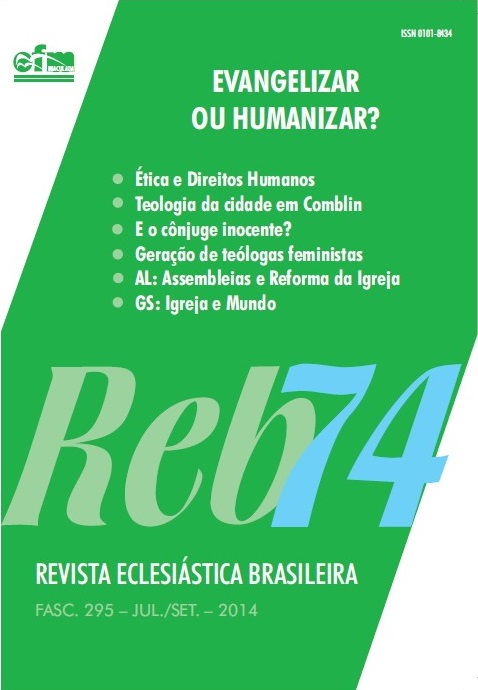Inexplicável silêncio ante a situação do cônjuge inocente
DOI:
https://doi.org/10.29386/reb.v74i295.483Keywords:
Cônjuge inocente, Cônjuge abandonado, Magistério da Igreja, Concílio Vaticano II, Concílio de TrentoAbstract
A respeito do problema do “cônjuge inocente abandonado”, observa-se um inexplicável silêncio, seja da parte do Magistério da Igreja, seja da parte dos teólogos e estudiosos. Durante as seções do Concílio Vaticano II e do Sínodo dos Bispos sobre a Família (1980), houve alguns convites para ocupar-se com esta questão. O Concílio de Trento condenou com “anátema” a quem negasse que o adultério desfaz o vínculo conjugal, mesmo em caso de cônjuge inocente. Não obstante os limites que este “anátema” comporta, parece que a doutrina da Igreja se estratificou. Hoje, a reflexão teológica coloca perspectivas que permitem que se vá ao encontro deste problema em função de uma solução pastoral.
Abstract: Regarding the issue of the “innocent spouse abandoned”, we notice there is an inexplicable silence either on the part of the Church’s Magisterium or on the part of theologians and scholars. During the sessions of the Second Vatican Council and the Synod of Bishops on the Family (1980), there have been some suggestions that we should deal with this question. The Council of Trent condemned as “anathema” those who denied that adultery dissolves the marriage bond, even in the case of an innocent spouse. Notwithstanding the limits that this “anathema” holds, it seems that the doctrine of the Church became stratified. Today, theological reflection points to perspectives that allow us to meet this problem in terms of a pastoral solution.
Keywords: Innocent spouse. Spouse abandoned. Magisterium of the church. Vatican Council II. Council of Trent.
Downloads
Downloads
Published
How to Cite
Issue
Section
License
Copyright (c) 2018 Revista Eclesiástica Brasileira

This work is licensed under a Creative Commons Attribution 4.0 International License.
Os autores cedem os direitos autorais; como gratificação, a REB oferece dois exemplares ao Autor de um artigo.
A REB adere à licença não comercial (Creative Commons). Portanto, é permitida cópia, distribuição e exibição dos textos, respeitados os direitos autorais e citada a fonte de sua proveniência.


